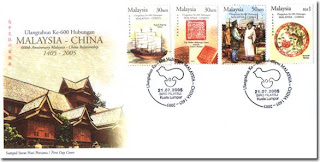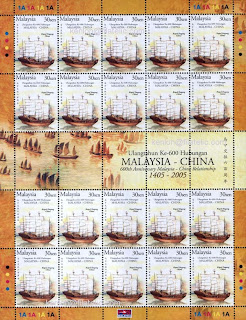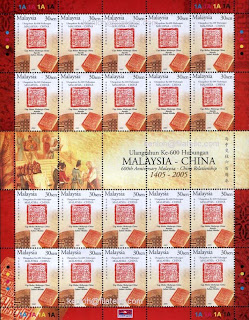 This year marks the 600th year of Admiral Zheng He's first expedition to Malacca. Up till today, Malaysia regards China as a major trading and business partner and bilateral economic cooperation remains the cornerstone of Malaysia - China policy. Evidence of early trade can be found in the form of tin coins used extensively by merchants. Later, imports and exports of Islamic ceramics and Nyonya ware in the 16th and 18th centuries respectively revealed that the connection between the countries had gone beyond economic and diplomatic relations - it has encroached into our custom and way of life.
This year marks the 600th year of Admiral Zheng He's first expedition to Malacca. Up till today, Malaysia regards China as a major trading and business partner and bilateral economic cooperation remains the cornerstone of Malaysia - China policy. Evidence of early trade can be found in the form of tin coins used extensively by merchants. Later, imports and exports of Islamic ceramics and Nyonya ware in the 16th and 18th centuries respectively revealed that the connection between the countries had gone beyond economic and diplomatic relations - it has encroached into our custom and way of life.As we commemorate the Malaysia - China relationship that had spanned over six centuries, we become more appreciative of the importance of working closely to promote economic growth and political stability in the region. This anniversary marks a new level of friendship between the two nations. As we move into the 21st century, this relationship is pertinent especially in the face of challenges in the global environment.
 Merchant Ships
Merchant ShipsBetween 1405 and 1433, Admiral Zheng He commanded a fleet of 62 treasure ships and more than 100 other vessels to Malacca and 30 other countries in the South China Sea, Indian Ocean, Arabian and Mediterranean Sea. The ships carried crews of sailors, officers, translators, warriors, pilots, medicinal experts and craftsmen. Merchant ships also brought with them silk, porcelain ware, tea and gun powder for trading in exchange for local spices and other goods such as glassware, oils, textile cotton and fruits from South and West Asia.
The Emperor of China's Royal Seal to the Sultan of Malacca
China and Malacca enjoyed good diplomatic relations when in 1411, Parameswara led a contingent of 540 envoys to China, in which during the visit, an edict was promulgated appointing Parameswara as the king of Malacca and granted an inscription for the sate mountain (country).
 A Royal Seal from the Emperor of China was presented to the Sultan of Melaka in recognition of the importance of diplomatic relationship between the two kingdoms. In the following years between 1414 and 1434, other Malacca Sultan also visited China.
A Royal Seal from the Emperor of China was presented to the Sultan of Melaka in recognition of the importance of diplomatic relationship between the two kingdoms. In the following years between 1414 and 1434, other Malacca Sultan also visited China.Trading in Malacca
During the 15th century, Malacca developed to become the most important commercial center in Southeast Asia. Malacca's location and sound government attracted merchants from China, India and Middle East who recognized its potential as an independent port where trade goods could be exchanged.
 Nyonya Ceramics
Nyonya CeramicsNyonya ware was first produced during the late 18th century. These were specially made on consignment for the Straits-born Chinese of Malacca. Nyonya ware is distinguished by their bright color combinations of pink, yellow, dark blue and green. The designs generally found on the ware are fish, phoenixes, flowers such as roses and chrysanthemum and other favored animals. These highly treasured wares were produced in Juangxi and Guangdong province of China. They come in different shapes and sizes but were mainly dining sets, tea sets, vases and other such items.
Currency
 Besides barter trading, coins and other money were extensively used in 15th century Malacca. Early Chinese merchants introduced tin animal money in the form of rooster, tortoise, fish and crocodile. During Zheng He's trade missions to Malacca, copper coins were issued and used by most merchants, but were subsequently replaced with tin which were mined and minted in Malacca.
Besides barter trading, coins and other money were extensively used in 15th century Malacca. Early Chinese merchants introduced tin animal money in the form of rooster, tortoise, fish and crocodile. During Zheng He's trade missions to Malacca, copper coins were issued and used by most merchants, but were subsequently replaced with tin which were mined and minted in Malacca. Technical Details
Technical DetailsDate of Issue : 21-Jul-2005
Stamp Value : 30 Sen (2 designs); 50 Sen; RM 1.00
Stamp Size : 30 mm X 40 mm
Perforation : 14
Sheet Content : 20 Stamps
Paper : SPM Watermarked, Phosphor Coated
Printing Process : Lithography
Printer : Percetakan Keselamatan Nasional Sdn. Bhd.
Stamp Designer : Reign Associates Sdn. Bhd.
First Day Cover Value : 30 Sen
Presentation Pack Value : RM 4.00
Miniature Sheet Value : RM 2.00
Folder Value : RM 5.00
|
|










0 comments:
Post a Comment